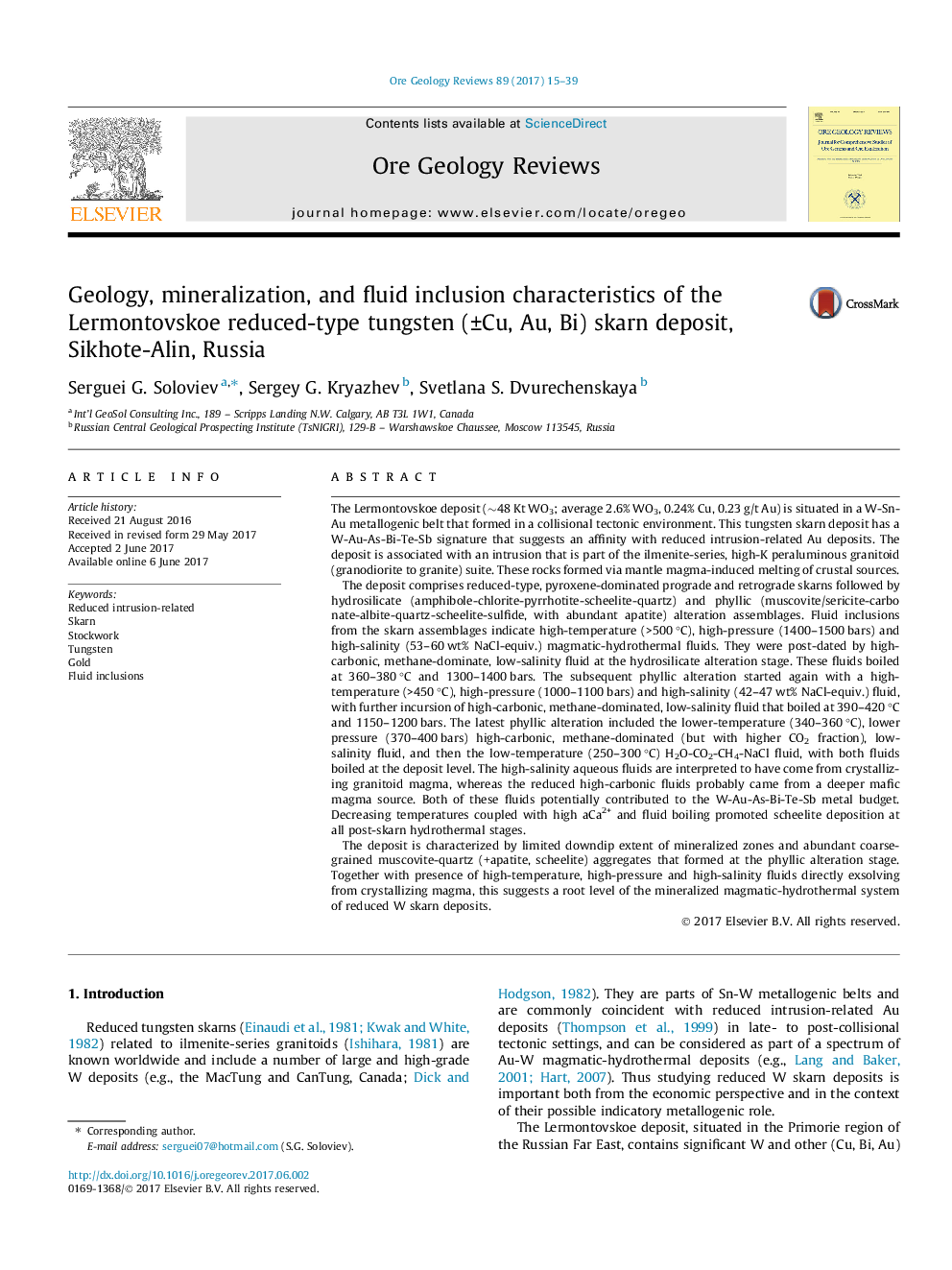| Article ID | Journal | Published Year | Pages | File Type |
|---|---|---|---|---|
| 5782230 | Ore Geology Reviews | 2017 | 25 Pages |
â¢The deposit is an example of reduced-type W skarn related to high-K peraluminous igneous suite.â¢Two to three major stages of scheelite and sulfide deposition occurred.â¢Fluid evolution included incursions of high-salinity NaCl-dominated fluids and essentially carbonic fluids.â¢The deposit represents a root level of reduced intrusion-related W-Au deposits.
The Lermontovskoe deposit (â¼48 Kt WO3; average 2.6% WO3, 0.24% Cu, 0.23 g/t Au) is situated in a W-Sn-Au metallogenic belt that formed in a collisional tectonic environment. This tungsten skarn deposit has a W-Au-As-Bi-Te-Sb signature that suggests an affinity with reduced intrusion-related Au deposits. The deposit is associated with an intrusion that is part of the ilmenite-series, high-K peraluminous granitoid (granodiorite to granite) suite. These rocks formed via mantle magma-induced melting of crustal sources.The deposit comprises reduced-type, pyroxene-dominated prograde and retrograde skarns followed by hydrosilicate (amphibole-chlorite-pyrrhotite-scheelite-quartz) and phyllic (muscovite/sericite-carbonate-albite-quartz-scheelite-sulfide, with abundant apatite) alteration assemblages. Fluid inclusions from the skarn assemblages indicate high-temperature (>500 °C), high-pressure (1400-1500 bars) and high-salinity (53-60 wt% NaCl-equiv.) magmatic-hydrothermal fluids. They were post-dated by high-carbonic, methane-dominate, low-salinity fluid at the hydrosilicate alteration stage. These fluids boiled at 360-380 °C and 1300-1400 bars. The subsequent phyllic alteration started again with a high-temperature (>450 °C), high-pressure (1000-1100 bars) and high-salinity (42-47 wt% NaCl-equiv.) fluid, with further incursion of high-carbonic, methane-dominated, low-salinity fluid that boiled at 390-420 °C and 1150-1200 bars. The latest phyllic alteration included the lower-temperature (340-360 °C), lower pressure (370-400 bars) high-carbonic, methane-dominated (but with higher CO2 fraction), low-salinity fluid, and then the low-temperature (250-300 °C) H2O-CO2-CH4-NaCl fluid, with both fluids boiled at the deposit level. The high-salinity aqueous fluids are interpreted to have come from crystallizing granitoid magma, whereas the reduced high-carbonic fluids probably came from a deeper mafic magma source. Both of these fluids potentially contributed to the W-Au-As-Bi-Te-Sb metal budget. Decreasing temperatures coupled with high aCa2+ and fluid boiling promoted scheelite deposition at all post-skarn hydrothermal stages.The deposit is characterized by limited downdip extent of mineralized zones and abundant coarse-grained muscovite-quartz (+apatite, scheelite) aggregates that formed at the phyllic alteration stage. Together with presence of high-temperature, high-pressure and high-salinity fluids directly exsolving from crystallizing magma, this suggests a root level of the mineralized magmatic-hydrothermal system of reduced W skarn deposits.
Graphical abstractDownload high-res image (108KB)Download full-size image
